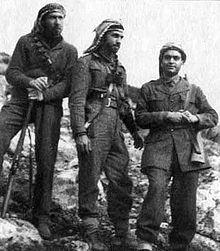Abdel Hamid al-Sarraj
Abdel Hamid Sarraj عبد الحميد السراج | |
|---|---|
Chairman of the Executive Council of the Northern Region of the United Arab Republic | |
| In office 20 September 1960 – 16 August 1961 | |
| Prime Minister | Gamal Abdel Nasser |
| Preceded by | Nur al-Din Kahala |
| Succeeded by | Maamun al-Kuzbari |
| Personal details | |
| Born | September 1925 French Syria |
| Died | 23 September 2013 (aged 87–88) Cairo, Egypt |
| Occupation | Minister of Interior (1958–1961) Vice-president (1961) |
| Military service | |
| Rank | Colonel |
Abdel Hamid Sarraj (
Early life

Sarraj was born in
Political career
He played a role in the 1949 coup that removed
Role in the United Arab Republic

When the union between Egypt and Syria was declared, Sarraj, a staunch supporter of Egyptian president
On 20 September 1960, he was appointed President of the Syrian Executive Council (SEC). Sarraj, at age 35, became the most powerful Syrian official in the UAR.
On 18 September, when Nasser merged the two branches of the National Union, therefore depriving Sarraj of his position as Secretary-General of the Syrian branch and when Egyptian vice president Abdel Hakim Amer dismissed one of his closest associates, Sarraj submitted his resignation. The UAR's state minister, Abdel Qadir Hatem, was sent to mediate between Sarraj and Amer, but failed and the former began mobilizing his forces on 19–20 September. Realizing an operation against Nasser was unlikely to succeed, he agreed to meet Nasser and Amer in Cairo. Although Nasser condemned Sarraj for his ambition to be sole ruler of Syria, he replaced Amer as Minister of Syrian Affairs with Mahmoud Riad. Resuming his post as Syria's vice president, Sarraj also headed a ministerial committee for UAR administrative reform. However, he suddenly submitted a second resignation on 26 September and Nasser accepted it, sending Amer to replace him.[13]
Later life and death

On 28 September 1961, a coup by disaffected officers occurred in Syria, dissolving the UAR. Sarraj was arrested and jailed in the
Sarraj did not return to Syria and died in Cairo on 23 September 2013. He had requested to be buried in Syria, but due to the unstable security condition of the country amid the civil war, he was buried in Cairo.[5]
Further reading
- Wilford, Hugh (2013). America's Great Game: The CIA's Secret Arabists and the Shaping of the Modern Middle East. Basic Books. p. 255. ISBN 9780465069828.
Sarraj Syria Kurd.
References
Citations
- S2CID 154295870.
- ISBN 9780815630937.
- ^ Wilford, p. 255.
- ^ "حكاية رجل الرعب عبد الحميد السراج". asharqalarabi.org.uk (in Arabic). 10 October 2013. Archived from the original on 24 November 2019. Retrieved 11 February 2019.
- ^ a b c The Death of Abdul Hamid Sarraj, Vice President of Gamal Abdel Nasser Archived 28 September 2013 at the Wayback Machine. Elbashayer. 2013-09-25.
- ^ a b c d Podeh 1999, p. 126.
- ^ Nazzal 1978, p. 40.
- ISBN 978-1-86064-467-2.
- ^ Podeh 1999, p. 35.
- ^ Podeh 1999, p. 54.
- ^ Podeh 1999, p. 110.
- ^ Podeh 1999, pp. 128–129.
- ^ Podeh 1999, p. 147.
- ^ a b Moubayed, Sami. Soft de-Baathification in Syria Archived 27 July 2009 at the Wayback Machine. Al-Ahram Weekly. 18 May 2005.
- ^ a b Moubayed, p. 326.
- ^ "Syria: The Roots of Tyranny". www.aljazeera.com. Retrieved 27 August 2023.
Bibliography
- Nazzal, Nafez (1978), The Palestinian exodus from Galilee, 1948, Institute for Palestine Studies
- Podeh, Elie (1999), The Decline of Arab Unity: The Rise And Fall of the United Arab Republic, Sussex Academic Press, ISBN 1-84519-146-3






